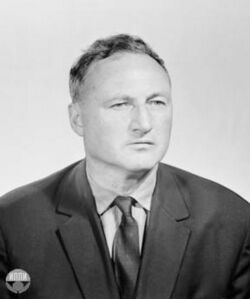Biography:Yuri Linnik
Yuri Linnik | |
|---|---|
 | |
| Born | Yuri Vladimirovich Linnik January 8, 1915 Bila Tserkva, Russian Empire |
| Died | June 30, 1972 (aged 57) Leningrad, Soviet Union |
| Nationality | Russian |
| Alma mater | Saint Petersburg University Steklov Institute |
| Scientific career | |
| Fields | Mathematics |
| Institutions | Saint Petersburg University |
Yuri Vladimirovich Linnik (Russian: Ю́рий Влади́мирович Ли́нник; January 8, 1915 – June 30, 1972) was a Soviet mathematician active in number theory, probability theory and mathematical statistics.
Biography
Linnik was born in Bila Tserkva, in present-day Ukraine . He went to Saint Petersburg University where his supervisor was Vladimir Tartakovsky, and later worked at that university and the Steklov Institute. He was a member of the Academy of Sciences of the Soviet Union, as was his father, Vladimir Pavlovich Linnik. He was awarded both Stalin and Lenin Prizes. He died in Leningrad.[1]
Work in number theory
- Linnik's theorem in analytic number theory
- The dispersion method (which allowed him to solve the Titchmarsh problem).[2]
- The large sieve (which turned out to be extremely influential).
- An elementary proof of the Hilbert-Waring theorem; see also Schnirelmann density.
- The Linnik ergodic method, see (Linnik 1968), which allowed him to study the distribution properties of the representations of integers by integral ternary quadratic forms.[3]
Work in probability theory and statistics
Infinitely divisible distributions
Linnik obtained numerous results concerning infinitely divisible distributions.[4] In particular, he proved the following generalisation of Cramér's theorem: any divisor of a convolution of Gaussian and Poisson random variables is also a convolution of Gaussian and Poisson.
He has also coauthored the book (Linnik Ostrovskii) on the arithmetics of infinitely divisible distributions.
Central limit theorem
- Linnik zones (zones of asymptotic normality)
- Information-theoretic proof of the central limit theorem
Statistics
Selected publications
- Linnik, Yu.V. (1971), Independent and stationary sequences of random variables, Series of Monographs and Textbooks on Pure and Applied Mathematics, Groningen: Wolters-Noordhoff Publishing
- Linnik, Yu.V. (1961), Method of least squares and principles of the theory of observations, New York-Oxford-London-Paris: Pergamon Press
- Linnik, Yu.V.; Ostrovskii, I.V. (1977), Decomposition of random variables and vectors, Translations of Mathematical Monographs, 48, Providence, R.I.: American Mathematical Society
- Linnik, Yu.V. (1968), Ergodic properties of algebraic fields, Ergebnisse der Mathematik und ihrer Grenzgebiete, 45, New York: Springer-Verlag New York Inc.
Notes
- ↑ Faddeyev, D. K.; Lozinsky, S. M.; Malyshev, A. V. (1975), "Yuri V. Linnik (1915–1972): a biographical note", Acta Arith. 27: 1–2, doi:10.4064/aa-27-1-1-2.
- ↑ Hazewinkel, Michiel, ed. (2001), "Density method", Encyclopedia of Mathematics, Springer Science+Business Media B.V. / Kluwer Academic Publishers, ISBN 978-1-55608-010-4, https://www.encyclopediaofmath.org/index.php?title=D/d033370
- ↑ Michel, Ph.; Venkatesh, A. (2006), "Equidistribution, L-functions and ergodic theory: on some problems of Yu. V. Linnik", Proceedings of ICM 2006, 2, Zurich: Eur. Math. Soc., pp. 421–457
- ↑ Ibragimov, I. A. (1992), "Yu. V. Linnik. Some of his work from the 1950s", St. Petersburg Math. J. 3 (3): 687–696.
External links
- Yuri Linnik at the Mathematics Genealogy Project
- O'Connor, John J.; Robertson, Edmund F., "Yuri Linnik", MacTutor History of Mathematics archive, University of St Andrews, http://www-history.mcs.st-andrews.ac.uk/Biographies/Linnik.html.
- Acta Arithmetica: Linnik memorial issue (1975)
- List of books by Linnik provided by National Library of Australia
 |

